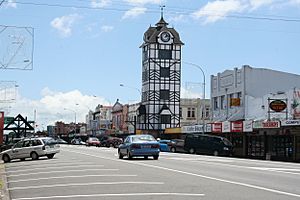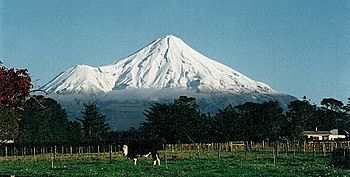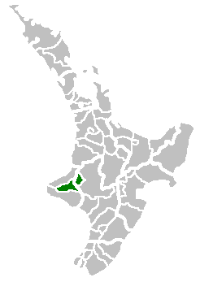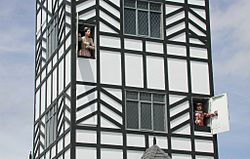Stratford, New Zealand facts for kids
Quick facts for kids
Stratford
Whakaahurangi (Māori)
|
|
|---|---|
|
Minor urban area
|
|
 |
|
| Country | |
| Region | Taranaki |
| Territorial authority | Stratford District |
| Ward | Urban |
| Area | |
| • Minor urban area | 8.54 km2 (3.30 sq mi) |
| • District | 2,163.42 km2 (835.30 sq mi) |
| Elevation | 310 m (1,020 ft) |
| Population
(June 2023)
|
|
| • Urban | 6,320 |
| • District | 10,300 |
| • District density | 4.761/km2 (12.33/sq mi) |
| Postcode |
4332
|
| Area code(s) | 06 |
Stratford (Māori: Whakaahurangi) is the only town in Stratford District, and the seat of the Taranaki region, in New Zealand's North Island. It lies beneath the eastern slopes of Mount Taranaki, approximately halfway between New Plymouth and Hāwera, near the geographic centre of the Taranaki Region. The town has a population of 6,320, making it the 62nd largest urban area in New Zealand (using the Statistical Standard for Geographic Areas 2018 (SSGA18)), and the fourth largest in Taranaki (behind New Plymouth, Hāwera and Waitara).
The Stratford District has a population of 10,300, and a land area of 2,163.35 km2 (835.27 sq mi), which is divided between the Manawatū-Whanganui region (including the settlements of Whangamōmona, Marco and Tahora, 31.87% of its land area) and the Taranaki region (68.13% of its land area).
Contents
Geography
Road and rail
Stratford is at the junction of State Highway 3 and State Highway 43.
On State Highway 3 New Plymouth is 39 km north, Inglewood 21 km north, Eltham 11 km south and Hawera 30 km south.
On State Highway 43 Taumarunui is 146 km to the east. This road is known as "The Forgotten World Highway", due the scarcity of settlement along the road in contrast to its earlier history. A sign reads "No Petrol for 140 km".
Stratford railway station is the junction of the Marton–New Plymouth and Stratford–Okahukura lines.
Physical geography

The Stratford District takes in about one quarter of the Taranaki Region, and includes four major geological features: the Taranaki volcanic cone, its associated ring plain, the Patea River catchment, and the eastern hill country.
Taranaki Volcanic Cone
The south-eastern face of Mount Taranaki is in the Stratford district, the north-westernmost point of the district being the 2518 m high peak. From the peak the boundaries run almost due east and due south.
Pembroke Road winds up the mountain slope from Stratford to a carpark and lookout at "The Plateau", at 1172 m. Manganui skifield is a short hike from the carpark, across the Manganui Gorge.
On the south-eastern face of the mountain, Manaia Road gives access to Dawson Falls and the Konini Lodge, at 890 m altitude. The natural Wilkies Pools are a short hike above the lodge.
Taranaki Volcanic Ring Plain
The Taranaki volcanic ring plain provides a steady contour with a subtle gradient, upon which Stratford and its environs have been settled. The easy gradient and rich volcanic soils and the high level of rainfall provide high quality pasture and agricultural land. Within this area the ring plain is drained by three river catchments: the Manganui River catchment to the north, the Waingongoro River catchment to the south, and the dominant Patea River catchment.
Patea River
The headwaters of the Patea River are on the eastern face of Mount Taranaki, above Stratford. From there the river flows eastwards, its upper catchment taking in a narrow area of land between the Manganui River catchment to the north and the Waingongoro River catchment to the south.
Stratford is on the banks of the Patea River, at the junction of the Patea River and Paetahi Stream, approximately 15 km east of the headwaters. Due to the narrow width of the catchment, the southern boundary of the town is on the Patea/Waingongoro divide, while 4 km to the north Midhirst is on the Patea/Manganui divide.
Beyond Stratford the catchment widens significantly to include a number of ancient swamps, including Ngaere and Toko, and also the Kahouri and Piakau ring plain streams. The river then takes in the expansive eastern hill country catchments of the Toko, Makuri, Mangaehu, Mangaotuku, Puniwhakau and Makahu Streams, before winding its way southwards through the hills of the South Taranaki district, to its mouth at Patea.
Eastern hill country
Beyond Stratford the district extends approximately 45 km to the east, between the Waitara River to the north and the Matemateaonga Ranges to the south, with the Whanganui River and Heao Stream constituting much of the district's eastern boundary. This area is dominated by steep sandstone, greywacke and mudstone hills and winding valleys. Much of the steep and isolated hill country is in native or exotic forestry. The remainder of the district is in sheep and/or beef pastoral farming.
Much of the eastern hill country falls within the catchment of the Patea River and its tributaries. However, to the north the district takes in Waitara River and its tributaries, including the Makara, Makino, Matau, Mangapapa and Mangaowata catchments. At its northernmost point the district also includes the Mt Damper Stream and its associated swamp and falls, which feed into the Tongaporutu River.
In the east the district takes in the Whangamomona River catchment, and also most of the Tangarakau River catchment, both of which feed into the Whanganui River. This area is separated from the west by the densely forested Whangamomona Saddle, making it an isolated and distinctive part of the district, and the area once had its own county council.
To the south-east the district also takes in the upper reaches of the Waitotara River catchment, within the Matemateaonga Ranges and the Waitotara Conservation Area.
Surrounding settlements
Stratford is surrounded by a number of small villages and settlements. To the north on State Highway 3 are Midhirst and beyond that Waipuku, and to the south is the locality of Ngaere. Cardiff, Mahoe, Rowan and Pembroke are beneath the mountain to the west, and Wharehuia, Tuna, Te Popo and Kupe are to the north-east.
To the east, along State Highway 43 and the Stratford-Okahukura railway, lie settlements that in their heyday were bustling villages. Toko and the renowned Whangamomona have retained their character as villages, while the settlements of Douglas, Strathmore, Huiakama, Te Wera, Pohokura, Marco, Kohuratahi and Tahora now consist of no more than a few houses. Along roads off State Highway 3 are a number of other settlements, some of which were also once bustling villages. Huiroa, Kiore, Matau and Mt. Damper are to the north and west of the highway, and Huinga, Tututawa, Puniwhakau, Makahu, Aotuhia and Tangarakau are to the south and east.
National parks
Stratford is the gateway to two National Parks - Egmont National Park to the west, and Whanganui National Park to the east (via Kohi Saddle, Aotuhia).
Population
Stratford is a rural service centre, serving the agricultural economy of its wider hinterland.
The population of the district peaked in 1961 at 11,300, and until the end of the century the town has fluctuated between 5229 (2001) and 5664 (1996).
The 21st century has seen significant economic growth and some associated population growth in the town. In the 2013 census the district population was 8988, with 5466 in the township and 3522 in the surrounding rural area. The 2006 census was the first time that the town had recorded population growth since the 1991 census.
History and culture
Whakaahurangi
The Māori name for Stratford is Whakaahurangi, meaning face to the sky. The name is taken from a story of a Patea chieftainess named Ruapu-tahanga who, returning from a visit to Kawhia, camped overnight near the location of the current town. Being a clear night, Ruaputahanga lay contemplating the stars when slumber overtook her. Withdrawing in respect, her followers observed that their chieftainess slept "with her face to the sky". The site continued to be used as a camping place for Māori along what became known as the Whakaahurangi track, linking the south Taranaki tribes to those in north Taranaki, and further north to Kawhia. Each traveling party would recollect the story of Ruapu-tahanga sleeping with her face to the sky. The name is fitting, given the exposure of the area to a broad horizon on the face of the mountain’s ring plain.
Surveying
There is no record of Māori settlement in the vicinity of Stratford. Before British settlement the area was covered in dense forest and swamp. The Vogel schemes of the 1870s provided the necessary impetus to lead to the construction of a railway line south of New Plymouth, and the creation of road access at the same time, to open up access to the rich soils under the mountain.
In 1876, Taranaki Waste Lands Board assistant surveyor Edwin Stanley Brookes, Jnr. cut a meridian line from Waitara to the site of Stratford, and oversaw the subdivision of a block between the Manganui River and the Patea River. The surveying of a new site for a town on the banks of the Patea River was authorised on 11 June 1877, and the northern half of the town (above the Patea River) was laid out by William Skinner in July. More lots were laid out by Peter Cheal in 1879, and in 1880 Skinner was directed to survey the southern half of the town.
Naming
On 3 December 1877, the name Stratford-upon-Patea was adopted, on the motion of William Crompton of the Taranaki Waste Lands Board. The supposed similarity of the Patea River to the River Avon in England led to the adoption of this name, and Crompton was known to have a literary turn of mind. There was a trend at the time to name towns after the birthplace of prominent British men. The William Shakespeare 'connection' led to the naming of 67 streets after Shakespearian characters from 27 of his plays.
Today New Zealand's only glockenspiel clock tower plays the balcony scene from Romeo and Juliet three times a day. The spoken words are provided via external loudspeakers - there is no carillon (multiple bells) as would be more typical for glockenspiels in towers.
Settlement and growth
Stratford was formally classified as a town in June 1878, and on 31 August 1878 an auction of 455 sections saw the first sections sold. By 1881 the population was 97, comprising 56 males and 41 females, with 22 houses. By 1891 this had grown to a population of 342 and by 1896 1,256. This growth continued steadily until the mid-late 20th century, and has since fluctuated between 5229 (2001) and 5664 (1996), numbering 5,337 at the last census.
Parks and reserves
Stratford has a number of public parks and reserves, with names reflecting its English and Māori heritage;
- King Edward Park
- Victoria Park
- Windsor Park
- Kopuatama Cemetery
Sister cities
 Stratford, Ontario, Canada
Stratford, Ontario, Canada Stratford, Connecticut, United States
Stratford, Connecticut, United States Stratford-upon-Avon, England
Stratford-upon-Avon, England



